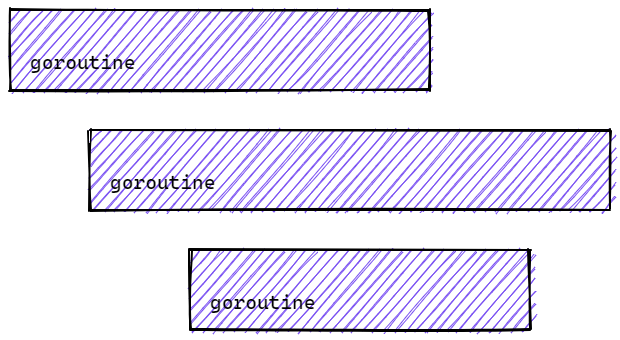Go语言并发编程-Context上下文
Context上下文
Context概述
Go 1.7 标准库引入 context,译作“上下文”,准确说它是 goroutine 的上下文,包含 goroutine 的运行状态、环境、现场等信息。
context 主要用来在 goroutine 之间传递上下文信息,包括:取消信号、超时时间、截止时间、k-v 等。
随着 context 包的引入,标准库中很多接口因此加上了 context 参数,例如 database/sql 包。context 几乎成为了并发控制和超时控制的标准做法。
在一组goroutine 之间传递共享的值、取消信号、deadline是Context的作用。
以典型的HTTPServer为例:

我们以 Context II为例,若没有上下文信号,当其中一个goroutine出现问题时,其他的goroutine不知道,还会继续工作。这样的无效的goroutine积攒起来,就会导致goroutine雪崩,进而导致服务宕机!
没有同步信号:

增加同步信号:

参考:Context传递取消信号 小结。
Context 核心结构
context.Context 是 Go 语言在 1.7 版本中引入标准库的接口,该接口定义了四个需要实现的方法:
type Context interface {// 返回被取消的时间Deadline() (deadline time.Time, ok bool)// 返回用于通知Context完结的channel// 当这个 channel 被关闭时,说明 context 被取消了// 在子协程里读这个 channel,除非被关闭,否则读不出来任何东西Done() <-chan struct{}// 返回Context取消的错误Err() error// 返回key对应的valueValue(key any) any}
除了Context接口,还存在一个canceler接口,用于实现Context可以被取消:
type canceler interface {cancel(removeFromParent bool, err error)Done() <-chan struct{}}
除了以上两个接口,还有4个预定义的Context类型:
// 空Contexttype emptyCtx int// 取消Contexttype cancelCtx struct {Contextmu sync.Mutex // protects following fieldsdone atomic.Value // of chan struct{}, created lazily, closed by first cancel callchildren map[canceler]struct{} // set to nil by the first cancel callerr error // set to non-nil by the first cancel call}// 定时取消Contexttype timerCtx struct {cancelCtxtimer *time.Timer // Under cancelCtx.mu.deadline time.Time}// KV值Contexttype valueCtx struct {Contextkey, val any}
默认(空)Context的使用
context 包中最常用的方法是 context.Background、context.TODO,这两个方法都会返回预先初始化好的私有变量 background 和 todo,它们会在同一个 Go 程序中被复用:
-
context.Background, 是上下文的默认值,所有其他的上下文都应该从它衍生出来,在多数情况下,如果当前函数没有上下文作为入参,我们都会使用
context.Background作为起始的上下文向下传递。 -
context.TODO,是一个备用,一个context占位,通常用在并不知道传递什么 context的情形。
使用示例,database/sql包中的执行:
func (db *DB) PingContext(ctx context.Context) errorfunc (db *DB) ExecContext(ctx context.Context, query string, args ...any) (Result, error)func (db *DB) QueryContext(ctx context.Context, query string, args ...any) (*Rows, error)func (db *DB) QueryRowContext(ctx context.Context, query string, args ...any) *Row
方法,其中第一个参数就是context.Context。
例如:操作时:
db, _ := sql.Open("", "")query := "DELETE FROM `table_name` WHERE `id` = ?"db.ExecContext(context.Background(), query, 42)
当然,单独 database.sql包中,也支持不传递context.Context的方法。功能一致,但缺失了context.Context相关功能。
func (db *DB) Exec(query string, args ...any) (Result, error)
context.Background 和 context.TODO 返回的都是预定义好的 emptyCtx 类型数据,其结构如下:
// 创建方法func Background() Context {return background}func TODO() Context {return todo}// 预定义变量var (background = new(emptyCtx)todo = new(emptyCtx))// emptyCtx 定义type emptyCtx intfunc (*emptyCtx) Deadline() (deadline time.Time, ok bool) {return}func (*emptyCtx) Done() <-chan struct{} {return nil}func (*emptyCtx) Err() error {return nil}func (*emptyCtx) Value(key any) any {return nil}func (e *emptyCtx) String() string {switch e {case background:return "context.Background"case todo:return "context.TODO"}return "unknown empty Context"}
可见,emptyCtx 是不具备取消、KV值和Deadline的相关功能的,称为空Context,没有任何功能。
Context传递取消信号
context.WithCancel 函数能够从 context.Context 中衍生出一个新的子上下文并返回用于取消该上下文的函数。一旦我们执行返回的取消函数,当前上下文以及它的子上下文都会被取消,所有的 Goroutine 都会同步收到这一取消信号。取消操作通常分为主动取消,定时取消两类。
主动取消
需要的操作为:
-
创建带有cancel函数的Context,func WithCancel(parent Context) (ctx Context, cancel CancelFunc)
-
接收cancel的Channel,ctx.Done()
-
主动Cancel的函数,cancel CancelFunc

示例代码:
func ContextCancelCall() {// 1. 创建cancelContextctx, cancel := context.WithCancel(context.Background())wg := sync.WaitGroup{}wg.Add(4)// 2. 启动goroutine,携带cancelCtxfor i := 0; i < 4; i++ {// 启动goroutine,携带ctx参数go func(c context.Context, n int) {defer wg.Done()// 监听context的取消完成channel,来确定是否执行了主动cancel操作for {select {// 等待接收c.Done()这个channelcase <-c.Done():fmt.Println("Cancel")returndefault:}fmt.Println(strings.Repeat(" ", n), n)time.Sleep(300 * time.Millisecond)}}(ctx, i)}// 3. 主动取消 cancel()// 3s后取消select {case <-time.NewTimer(2 * time.Second).C:cancel() // ctx.Done() <- struct{}}select {case <-ctx.Done():fmt.Println("main Cancel")}wg.Wait()}// ======> go test -run TestContextCancelCall31 0 2132 0 01 32 2130013221033012main CancelCancelCancelCancelCancelPASSok goConcurrency 2.219s
当调用cancel()时,全部的goroutine会从 ctx.Done() 接收到内容,进而完成后续控制操作。
func WithCancel(parent Context) (ctx Context, cancel CancelFunc) 函数返回的Context是 context.cancelCtx 结构体对象,以及一个CancelFunc。
其中 context.cancelCtx 结构如下:
// A cancelCtx can be canceled. When canceled, it also cancels any children
// that implement canceler.
type cancelCtx struct {Contextmu sync.Mutex // protects following fieldsdone atomic.Value // of chan struct{}, created lazily, closed by first cancel callchildren map[canceler]struct{} // set to nil by the first cancel callerr error // set to non-nil by the first cancel call
}
其中:
-
Context,上级Context对象
-
mu, 互斥锁
-
done,用于处理cancel通知信号的channel。懒惰模式创建,调用cancel时关闭。
-
children,以该context为parent的可cancel的context们
-
err,error
Deadline和Timeout定时取消
与主动调用 CancelFunc 的差异在于,定时取消,增加了一个到时自动取消的机制:
-
Deadline,某个时间点后,使用
func WithDeadline(parent Context, d time.Time) (Context, CancelFunc)创建 -
Timeout,某个时间段后,使用
func WithTimeout(parent Context, timeout time.Duration) (Context, CancelFunc)创建
示例代码如下,与主动cancel的代码类似:
// 1s后cancel ctx, cancel := context.WithTimeout(context.Background(), 1*time.Second)// 每天 20:30 cancel curr := time.Now() t := time.Date(curr.Year(), curr.Month(), curr.Day(), 20, 30, 0, 0, time.Local) ctx, cancel := context.WithDeadline(context.Background(), t)
其他代码一致,当时间到时,ctx.Done() 可以接收内容,进而控制goroutine停止。
不论WithDeadline和WithTimeout都会构建 *timerCtx 类型的Context,结构如下:
// A timerCtx carries a timer and a deadline. It embeds a cancelCtx to
// implement Done and Err. It implements cancel by stopping its timer then
// delegating to cancelCtx.cancel.
type timerCtx struct {cancelCtxtimer *time.Timer // Under cancelCtx.mu.deadline time.Time
}
其中:
-
cancelCtx,基于parent构建的cancelCtx
-
deadline,cancel时间
-
timer,定时器,用于自动cancel
Cancel操作的向下传递
当父上下文被取消时,子上下文也会被取消。Context 结构如下:
ctxOne| \ ctxTwo ctxThree| ctxFour
示例代码:
func ContextCancelDeep() {ctxOne, cancel := context.WithCancel(context.Background())ctxTwo, _ := context.WithCancel(ctxOne)ctxThree, _ := context.WithCancel(ctxOne)ctxFour, _ := context.WithCancel(ctxTwo)// 带有timeout的cancel//ctxOne, _ := context.WithTimeout(context.Background(), 1*time.Second)//ctxTwo, cancel := context.WithTimeout(ctxOne, 1*time.Second)//ctxThree, _ := context.WithTimeout(ctxOne, 1*time.Second)//ctxFour, _ := context.WithTimeout(ctxTwo, 1*time.Second)cancel()wg := sync.WaitGroup{}wg.Add(4)go func() {defer wg.Done()select {case <-ctxOne.Done():fmt.Println("one cancel")}}()go func() {defer wg.Done()select {case <-ctxTwo.Done():fmt.Println("two cancel")}}()go func() {defer wg.Done()select {case <-ctxThree.Done():fmt.Println("three cancel")}}()go func() {defer wg.Done()select {case <-ctxFour.Done():fmt.Println("four cancel")}}()wg.Wait()
}
我们调用 ctxOne 的 cancel, 其后续的context都会接收到取消的信号。
如果调用了其他的cancel,例如ctxTwo,那么ctxOne和ctxThree是不会接收到信号的。
取消操作流程
创建cancelCtx的流程
使用 context.WithCancel, context.WithDeadlime, context.WithTimeout 创建cancelCtx或timerCtx的核心过程基本一致,以 context.WithCancel 为例:
func WithCancel(parent Context) (ctx Context, cancel CancelFunc) {if parent == nil {panic("cannot create context from nil parent")}// 构建cancelCtx对象c := newCancelCtx(parent)// 传播Cancel操作propagateCancel(parent, &c)// 返回值,注意第二个cancel函数的实现return &c, func() { c.cancel(true, Canceled) }
}func newCancelCtx(parent Context) cancelCtx {return cancelCtx{Context: parent}
}
由此可见,核心过程有两个:
-
newCancelCtx, 使用 parent 构建 cancelCtx
-
propagateCancel, 传播Cancel操作,用来构建父子Context的关联,用于保证在父级Context取消时可以同步取消子级Context
核心的propagateCancel 的实现如下:
// propagateCancel arranges for child to be canceled when parent is.
func propagateCancel(parent Context, child canceler) {// parent不会触发cancel操作done := parent.Done()if done == nil {return // parent is never canceled}// parent已经触发了cancel操作select {case <-done:// parent is already canceledchild.cancel(false, parent.Err())returndefault:}// parent还没有触发cancel操作if p, ok := parentCancelCtx(parent); ok {// 内置cancelCtx类型p.mu.Lock()if p.err != nil {// parent has already been canceledchild.cancel(false, p.err)} else {if p.children == nil {p.children = make(map[canceler]struct{})}// 将当前context放入parent.children中p.children[child] = struct{}{}}p.mu.Unlock()} else {// 非内置cancelCtx类型atomic.AddInt32(&goroutines, +1)go func() {select {case <-parent.Done():child.cancel(false, parent.Err())case <-child.Done():}}()}
}
以上代码在建立child和parent的cancelCtx联系时,处理了下面情况:
-
parent不会触发cancel操作,不做任何操作,直接返回
-
parent已经触发了cancel操作,执行child的cancel操作,返回
-
parent还没有触发cancel操作,
child会被加入parent的children列表中,等待parent释放取消信号 -
如果是自定义Context实现了可用的Done(),那么开启goroutine来监听parent.Done()和child.Done(),同样在parent.Done()时取消child。
如果是WithDeadline构建的timerCtx,构建的过程多了两步:
-
对截至时间的判定,判定是否已经截至
-
设置定时器
示例代码:
func WithDeadline(parent Context, d time.Time) (Context, CancelFunc) {if parent == nil {panic("cannot create context from nil parent")}if cur, ok := parent.Deadline(); ok && cur.Before(d) {// The current deadline is already sooner than the new one.return WithCancel(parent)}c := &timerCtx{cancelCtx: newCancelCtx(parent),deadline: d,}propagateCancel(parent, c)dur := time.Until(d)// 已过时if dur <= 0 {c.cancel(true, DeadlineExceeded) // deadline has already passedreturn c, func() { c.cancel(false, Canceled) }}c.mu.Lock()defer c.mu.Unlock()// 设置定时器if c.err == nil {c.timer = time.AfterFunc(dur, func() {c.cancel(true, DeadlineExceeded)})}return c, func() { c.cancel(true, Canceled) }
}
ctx.Done() 初始信号channel流程
以 cancelCtx 为例:
func (c *cancelCtx) Done() <-chan struct{} {// 加载已经存在的d := c.done.Load()if d != nil {return d.(chan struct{})}c.mu.Lock()defer c.mu.Unlock()// 初始化新的d = c.done.Load()if d == nil {d = make(chan struct{})c.done.Store(d)}return d.(chan struct{})
}
其中两个步骤:
-
先尝试加载已经存在的
-
后初始化新的
核心要点是,当调用Done()时,初始化chan struct{}, 而不是在上限文cancelCtx创建时,就初始化完成了。称为懒惰初始化。
cancel()操作流程
取消流程,我们以 cancelCtx 的主动取消函数cancel的实现为例:
// cancel closes c.done, cancels each of c's children, and, if
// removeFromParent is true, removes c from its parent's children.
func (c *cancelCtx) cancel(removeFromParent bool, err error) {if err == nil {panic("context: internal error: missing cancel error")}c.mu.Lock()if c.err != nil {c.mu.Unlock()return // already canceled}// 设置 errc.err = err// 关闭channeld, _ := c.done.Load().(chan struct{})if d == nil {c.done.Store(closedchan)} else {close(d)}// 遍历全部可取消的子contextfor child := range c.children {// NOTE: acquiring the child's lock while holding parent's lock.child.cancel(false, err)}c.children = nilc.mu.Unlock()// 从parent的children删除自己if removeFromParent {removeChild(c.Context, c)}
}
以上流程的核心操作:
-
关闭channel,用来通知全部使用该ctx的goroutine
-
遍历全部可取消的子context,执行child的取消操作
-
从parent的children删除自己
Context传值

若希望在使用context时,携带额外的Key-Value数据,可以使用 context.WithValue 方法,构建带有值的context。并使用 Value(key any) any 方法获取值。带有值
对应方法的签名如下:
func WithValue(parent Context, key, val any) Contexttype Context interface {Value(key any) any
}
需要三个参数:
-
上级 Context
-
key 要求是comparable的(可比较的),实操时,推荐使用特定的Key类型,避免直接使用string或其他内置类型而带来package之间的冲突。
-
val any
示例代码
type MyContextKey stringfunc ContextValue() {wg := sync.WaitGroup{}ctx := context.WithValue(context.Background(), MyContextKey("title"), "Go")wg.Add(1)go func(c context.Context) {defer wg.Done()if v := c.Value(MyContextKey("title")); v != nil {fmt.Println("found value:", v)return}fmt.Println("key not found:", MyContextKey("title"))}(ctx)wg.Wait()
}
context.WithValue 方法返回 context.valueCtx 结构体类型。context.valueCtx 结构体包含了上级Context和key、value:
// A valueCtx carries a key-value pair. It implements Value for that key and
// delegates all other calls to the embedded Context.
type valueCtx struct {Contextkey, val any
}func (c *valueCtx) Value(key any) any {if c.key == key {return c.val}return value(c.Context, key)
}
也就是除了 value 功能,其他Contenxt功能都由parent Context实现。
如果 context.valueCtx.Value 方法查询的 key 不存在于当前 valueCtx 中,就会从父上下文中查找该键对应的值直到某个父上下文中返回 nil 或者查找到对应的值。例如:
func ContextValueDeep() {wgOne := sync.WaitGroup{}ctxOne := context.WithValue(context.Background(), MyContextKey("title"), "One")//ctxOne := context.WithValue(context.Background(), MyContextKey("key"), "Value")//ctxTwo := context.WithValue(ctxOne, MyContextKey("title"), "Two")ctxTwo := context.WithValue(ctxOne, MyContextKey("key"), "Value")//ctxThree := context.WithValue(ctxTwo, MyContextKey("title"), "Three")ctxThree := context.WithValue(ctxTwo, MyContextKey("key"), "Value")wgOne.Add(1)go func(c context.Context) {defer wgOne.Done()if v := c.Value(MyContextKey("title")); v != nil {fmt.Println("found value:", v)return}fmt.Println("key not found:", MyContextKey("title"))}(ctxThree)wgOne.Wait()
}
小结
特定的结构体类型:
-
emptyCtx,函数 context.Background, context.TODO
-
cancelCtx,函数 context.WithCancel
-
timerCtx, 函数 context.WithDeadline, context.WithTimeout
-
valueCtx, 函数 context.WithValue
官方博客对Context使用的建议:
-
直接将 Context 类型作为函数的第一参数,而且一般都命名为 ctx。
-
如果你实在不知道传什么,标准库给你准备好了一个 context.TODO。
-
context 存储的应该是一些goroutine共同的数据。
-
context 是并发安全的。
